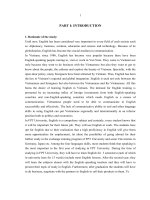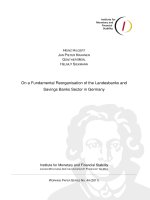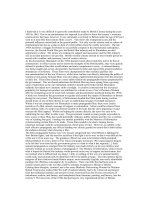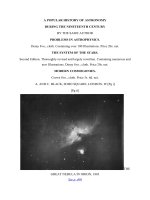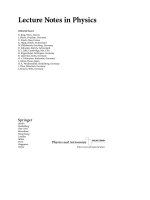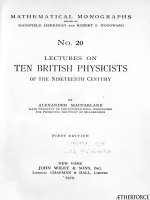alexander mcfarlane lectures on ten british physicists of the nineteenth century
Bạn đang xem bản rút gọn của tài liệu. Xem và tải ngay bản đầy đủ của tài liệu tại đây (10.63 MB, 151 trang )
MATHEMATICAL
MONOGRAPHS
EDITED BY
MANSFIELD MERRIMAN AND
ROBERT S.
WOODWARD
No. 20
v.
;',.';
' ,
LECTURES
ON
I'.
TEN
BRITISH
PHYSICISTS
OF THE
NINETEENTH
CENTURY
BT
ALEXANDER MACFARLANE
LATE
PRESIDENT
OF
THE
INTERNATIONAL
ASSOCIATION
FOR
PROMOTING THE
STUDY
OF
QUATERNIONS
FIRST
EDITION
NEW YORK
JOHN
WILEY
&
SONS,
INC.
LONDON:
CHAPMAN &
HALL,
LIMITED
'1919
ÆTHERFORCE
TAIT
WHEWELL
ADAMS
HERSCHEL
ÆTHERFORCE
ÆTHERFORCE
PREFACE
DURING
the
years
"1901-1904
Dr.
Alexander Macfarlane
delivered,
at
Lehigh
University,
lectures
on
twenty-five
British
mathematicians
of the nineteenth
century.
The
manuscripts
of
twenty
of these
lectures
were
discovered
in
1916,
three
years
after
the death
of
their
author,
to
be
almost
ready
for
the
printer,
and ten
of
them,
on
ten
pure
mathematicians,
were then
pub-
lished
in
Monograph
No.
17
of
this series. Lectures on
ten
mathematicians
whose main work
was
in
physics,
astronomy,
and
engineering
are
given
in
this volume.
These lectures
were
given
to audiences
composed
of
students,
instructors
and
townspeople,
and
each
occupied
less
than
an hour
in
delivery.
It should hence
not
be
expected
that
a lecture can
fully
treat
of
all
the activities
of
a
mathe-
matician,
much
less
give
critical
analyses
of
his work
and
care-
ful estimates
of his
influence.
It
is
felt
by
the
editors, however,
that
the
lectures
will
prove interesting
and
inspiring
to
a wide
circle
of readers
who
have
no
acquaintance
at first hand
with the
works
of the
men
who are
discussed,
while
they
cannot
fail
to
be
of
special
interest to older
readers who
have such
acquaintance.
It
should
be
borne in
mind
that
expressions
such as
"
now,"
"
recently,"
"
ten
years ago,"
etc.,
belong
to
the
year
when a
lecture
was
delivered.
On the
first
page
of
each
lecture will
be
found the
date
of
its
delivery.
For
five of
the
portraits
given
in
the
frontispiece
the editors
are indebted to
the kindness of Dr.
David
Eugene
Smith,
of
Teachers
College,
Columbia
University.
A
portrait
of Dr.
Macfarlane will be
found
on
page
4
of
Monograph
No.
17.
3
40557
ÆTHERFORCE
'
ÆTHERFORCE
CONTENTS
PORTRAITS
OF PHYSICISTS
Frontispiece
j
PAGE
JAMES
CLERK
MAXWELL
(1831-1879) 7
A Lecture
delivered
March
14, 1902.
WILLIAM
JOHN
MACQUORN
RANKINE
(1820-1872)
22
A Lecture
delivered March
18,
1902.
PETER
GUTHRIE
TAIT
(1831-1901) 38
A Lecture
delivered
March
22,
1902.
SIR WILLIAM
THOMSON,
FIRST LORD KELVIN
(1824-1907)
55
A
Lecture
delivered
March
25,
1902.
CHARLES
BABBAGE
(1791-1871) 71
A
Lecture delivered
April
21, 1903.
WILLIAM
WHEWELL
(1794-1866)
84
A
Lecture
delivered
April
23,
1903.
SIR
GEORGE
GABRIEL STOKES
(1819-1903)
94
A Lecture
delivered
April
28,
1903.
SIR
GEORGE
BIDDELL AIRY
(1801-1892)
106
A Lecture
delivered
April 7, 1904.
JOHN
COUCH
ADAMS
(1819-1892) 119
A Lecture
delivered
April
8,
1904.
y
SIR
JOHN
FREDERICK WILLIAM HERSCHEL
(1792-1871) 131
A Lecture delivered
April
n,
1904.
INDEX
143
5
ÆTHERFORCE
s
ÆTHERFORCE
TEN
BRITISH
PHYSICISTS
JAMES
CLERK
MAXWELL
*
(1831-1879)
JAMES
CLERK MAXWELL
was born
in
Edinburgh,
Scotland,
on
the
1
3th
of
November,
1831.
His
father,
John
Clerk,
belonged
to the
old
family
of
Clerks of
Penicuik near
Edinburgh,
and
he added
Maxwell
to
his
name,
on
succeeding
as a
younger
son
to the estate
of Middlebie
in
Dumfriesshire,
which
had for
generations
been the home of
a Maxwell.
Hence
it
was cus-
tomary
in
Scotland
to
speak
of
the
subject
of
our
lecture
as
Clerk-Maxwell;
but
by
the
world
at
large
the
"
Clerk
"
has
been
dropped;
for
instance
the
magnetic
unit
recently
defined
in his
honor is not denominated a
"Clerk
"
or a
"
Clerk-Max-
well,"
but
simply
a
"
Maxwell." His
father was
by profession
an
advocate,
that
is,
a
lawyer
entitled to
plead
before
the
Supreme
Court
of
Scotland;
his
practice
had never been
large
and at the
date
mentioned
he
had
retired to live
on
his
estate.
John
Clerk-Maxwell was of a
family, many
members of which
were
talented,
and not a few
eccentric;
to
the
latter
class he
himself
belonged.
He
took an
interest
in
all
useful
processes,
and was successful
in
extending
and
improving
the
stony
and
mossy
land which had become his
by
inheritance.
The
mother
of
James
Clerk
Maxwell
belonged
to
an old
family
of
the
north
of
England,
and was a woman of
practical
ability.
Glenlair was the
name
given
to the
new mansion
and
improved
estate.
Here
the
boy
had
every
opportunity
of
becoming
intimate with the
ways
of
nature.
He
traversed
the
*
This Lecture was
delivered
on
March
14, 1902.
EDITORS.
7
ÆTHERFORCE
8
AY)
;
tl
??^\
BRITISH
PHYSICISTS
country
with the
help
of a
leaping pole,
he
navigated
the
duck
pond
in a wash
tub,
he rode
a
pony
behind
his
father's
phaeton,
he
explored
the
potholes
and
grooves
in
the
stony
bed of
the
mountain
stream
which
flowed
past
the
house. He
studied the
ways
of
cats
and
dogs;
he
watched
the
transformation of
the
tadpole
into
the
frog,
and
he
imitated the
manner in
which a
frog
jumps.
But
he
attracted
attention
not
so much as an
incipient
naturalist as a
physicist.
He had
great
work with
doors,
locks
and
keys,
and his
constant
request
was
"
Show
me
hoo
it
doos."
He
investigated
the
course of
the water
from
the
duckpond
to
the
river,
and
the
courses of
the bell-wires from
the
pulls
to the
bells
in
the
kitchen,
"
action
at a distance
"
being
no
explanation
to
him.
When a
very
small
boy
he found
out how to reflect
the sun into the room
by
means of
a tin-
plate.
He
early acquired
manual skill
by
making
baskets,
knitting
elaborate
designs
and
taking part
in
such
other
opera-
tions as went
on
around
him,
whether in
the
parlor,
the
kitchen,
or on the farm.
Being
an
only
child,
young
Maxwell
made
playmates
of
the
children
of
the
workmen on
the
farm,
which
had one bad
effect;
the
Scottish dialect became such a
native
tongue
that
in after
life he
could not
get
rid
of the
brogue.
His
early
instruction
in
the
elements of education was
received
from his
mother.
She
taught
him
to
read,
stored his
mind
with
Scripture
knowledge,
and trained
him
to
look
up
through
Nature to Nature's God.
But
she died
from
cancer
at the
early age
of
48,
and
James
was left when
nine
years
old to
the
sole
charge
of his father. Education at
home
under
a tutor was
first
tried,
but
the result
was such that
preparations
were
made
to
send
him
to
the
Edinburgh Academy,
one
of
the
best
secondary
schools
of
the Scottish
metropolis.
He
entered
the
Academy
in
the
middle of a
term,
and his
reception
by
the
other
boys
was
not
auspicious.
His manners were
not
only
rustic but
eccentric;
he had a
hesitation
in his
speech,
and
he
was
clad
more for
comfort
than
for
fashion.
They
were
all
dressed
in
round
jacket
and
collar,
the
regulation
dress
for
boys
in the
public
schools
of
England;
he
came
in
a
gray
ÆTHERFORCE
JAMES
CLERK
MAXWELL
9
tweed tunic
and
frill;
and his shoes were
made
after
a
peculiar
design
of his father's with
square
toes
and
brass
buckles.
So
at the
first
recess,
when
they
were all
outside,
they
came
about
him
like
bees,
and demanded who made
his
shoes,
to
which he
replied
:
Din
ye
ken,
'twas a
man,
And
he lived in a
house
In whilk
was a mouse.
They
tore
his tunic
.and
frill,
and
gave
him
the
uncom-
plimentary
nickname
of
"
Dafty."
Daft
is
a
Scottish
word
meaning
deficient
in
sense,
or
silly.
Such
was the
first
reception
at
public
school of the
boy
who became the
greatest
mathe-
matical electrician
of
the nineteenth
century,
whose
electrical
work
in historical-
importance
has
been
judged
second
only
to
that of
Faraday.
Had the
annoyance
to
which
young
Maxwell was
exposed
been
confined
to
the
first few
days
at
school,
it
might
be
set down to that
disposition
to
haze
new-
comers
which
appears
to
be
part
of
a
boy's
nature
whether
in
the
Old World
or
the
New;
but it was too
generally
per-
sisted
in,
with
the
result that
young
Maxwell
never
quite
amalgamated
with the rest
of
the
boys.
There
were, however,
some
exceptional
lads who
could
appreciate
his
true
worth,
conspicuous
among
whom were
Peter
Guthrie
Tait,
afterwards
Professor
Tait,
and
Lewis
Campbell,
who
became his
biographer.
The curriculum
at the
Academy
was
largely
devoted to
Latin
and
Greek;
and
young
Maxwell
made a
bad
start
in
these
subjects.
A
want
of
readiness,
corresponding,
I
suppose,
to the
hesitation
in
his
speech,
kept
him
down,
even
in
arith-
metic. But
about
the
middle of
his
school career he
surprised
his
companions
by
suddenly becoming
one of
the
most
brilliant
among
them,
gaining
high,
and
sometimes the
highest
prizes
for
scholarship,
mathematics
and
English
verse
composition.
At
his home
in
Edinburgh,
his
aunt's
house,
he had
a room
all
to
himself;
it
was
not
a
study merely,
but a
laboratory.
There
before
he
had entered on the
study
of Euclid's Elements
at
the
Academy
he
made out
of
pasteboard
models
of
the five
regular
solids.
ÆTHERFORCE
10
TEN BRITISH
PHYSICISTS
But
while
still a school
boy
he
achieved a
mathematical
feat
which
was
much
more
brilliant.
His
father was a member
of
the
Scottish
Society
of
Arts and of
the
Royal
Society
of
Edinburgh,
and it was his custom
to
take his son
with
him
to the
meetings,
and
indeed
on
visits
to
all
places
of
scientific
and
industrial
interest.
A
prominent
member of
the
Society
of
Arts,
Mr. D.
R.
Hay,
a decorative
painter,
and
author
of a
book
First
Principles
of
Symmetrical
Beauty
read a
paper
before
that
Society
on how
to draw a
perfect
oval.
His
method was
by
means
of
a
string
passing
round
three
pegs.
Young
Maxwell
had
by
this time
entered
on
the
study
of
the
Conic
Sections,
and
he
took
up
the
problem
in
his
laboratory.
He modified
the
manner of
tracing
an
ellipse
by doubling
the cord
from
the
tracing-point
to
one of
the
foci;
the curve
then described is
the
oval
of
Descartes.
He also
found
out
how
to
do it
when
twice the
distance
from
one focus
plus
three
times the
distance
from the other focus
is
to
be
constant. Maxwell's
father
wrote
out
an
account
of
his son's
method,
and
gave
it to
J.
D.
Forbes,
then
professor
of
natural
philosophy
at the
University
of Edin-
burgh,
and
Secretary
of
the
Royal Society
of
Edinburgh.
Both
Forbes,
and
Kelland,
the
professor
of
mathematics,
approved
the
paper
as
containing
something
new
to
science;
it
was read
by
Forbes
at the next
meeting
of
the
Society,
and is
printed
in
the
second volume
of
the
Proceedings
under the title
"
On
the
description
of
oval
curves,
and those
having
a
plurality
of
foci;
By
Mr.
Clerk-Maxwell,
Jr.,
with
remarks
by
Professor
Forbes." The author was
then
15 years
of
age.
Next
year
(1847)
he
finished
the
curriculum at
the
Academy,
first in
mathematics
and in
English,
and
very
nearly
first
in Latin.
He now
became
a
student
of the
University
of
Edinburgh.
At
that time the
curriculum
in
Arts
embraced seven
subjects:
Latin,
Greek,
Mathematics,
Physics,
Logic
and
Metaphysics,
Moral
Philosophy,
English
Literature.
Maxwell made
a
selec-
tion
skipping
Latin,
Greek,
and
English
Literature. Kelland
was the
professor
of
mathematics,
Forbes of
physics,
Sir William
Hamilton
of
logic
and
metaphysics;
under
these
he studied
for
two
years.
To Kelland and Forbes
he
was
already
known,
ÆTHERFORCE
JAMES
CLERK
MAXWELL
11
and
the
latter
gave
him
the
special
privilege
of
working
with
the
apparatus
used in
the lectures
on
physics.
There
was
then no
well-appointed
physical
laboratory; any
research
made was conducted
in
the
lecture room or
the room for
storing
the
lecture
apparatus.
But
strange
as
it
may
seem,
Maxwell
appears
to have done
most work for
the
class
of
logic.
Sir
William Hamilton
(that
is,
the Scottish
baronet)
was noted for
his
attack on
mathematics as
an educational
discipline,
but
he
was
learned
in
scholastic
logic
and
philosophy,
and
he
had
the
power
of
inspiring
his
students.
It was
his custom to
on
a
board the names
of
the
best students
for
the
year
in
the
order of
merit;
I
recollect
seeing
on one
board the
name
of
James
Clerk
Maxwell,
I
think
about sixth in
the list.
About
this time
George
Boole
published
his Mathematical
Analysis of
Logic
which found in
Maxwell an
appreciative
reader. In his
third
year
at the
University,
besides
continuing
his
experiments
in
the
physical department,
he
took
Moral
Philosophy
under
Professor
Wilson,
who
wrote much
under the
name of
Christo-
pher
North
but
whose lectures on moral science were char-
acterized
by
Maxwell as
vague harangues;
also
Chemistry
in
the
department
of
Medicine,
and
there,
as in
Physics^
he
was
privileged
to make
experiments.
The
academic
session
at
Edinburgh
is
short
only
six
months;
the
long
vacations
he
spent
at
Glenlair,
where
he
fitted
up
a
small
laboratory
in
the
garret
of
the
former
dwelling
house.
There he
studied and
experimented
on
the
phenomena
of
light,
electricity
and
elastic-
ity.
As
the
outcome of
these
researches
he
contributed two
papers
to
the
Royal
Society
of
Edinburgh,
which
were
printed
in
the
Transactions;
one on
"
The
Theory
of
Rolling
Curves,"
the
other
on
"The
Equilibrium
of
Elastic Solids."
During
his
study
at
Edinburgh
University,
Maxwell made
great
use
of
the
high-class
works
on
mathematics
and
physics
which were
to
be
found in
the
University Library,
acting unconsciously
on
the
advice of
his
compatriot
and
subsequent neighbor
Thomas
Carlyle.
In
sending
his
son to
Edinburgh
University
it was
John
Maxwell's
intention to
educate
him for the
legal profession
ÆTHERFORCE
12
TEN
BRITISH PHYSICISTS
to become an
advocate
like himself.
But
the
youth's
success
as an
investigator
in
mathematics
and
physics
suggested
to
such friends as
Forbes, Kelland,
Thomson and
Blackburn,
a
scientific
career,
and
it
was Maxwell's
own
conviction
that
he
was
better
fitted to
grapple
with
the laws of
nature
than
with
the
laws
of
the land. His
former school
fellow
Tait,
after
studying
mathematics and
physics
for one brief
session
at the
University
of
Edinburgh,
had taken
up
the
regular
course
of
study
at the
University
of
Cambridge;
and he
wished to follow.
His
father was at
length persuaded,
with the result
that Maxwell
became
a member of
St. Peter's
College,
Cambridge,
at the
age
of
19.
Tait was a
member of
the same
college,
now
entering
on
the third and last
year
of his
undergraduate
course.
Thom-
son
was now a fellow of that
college.
The
change
to
Cambridge
involved a
great
discontinuity;
and Maxwell
by
nature loved
continuity
in
all
his life
and
surroundings.
The
investigator
of
rolling
curves
and the
compression
of solids
was now
obliged
to turn
his
attention
again
to the Elements
of
Euclid,
and
to
finding
out
by
the
aid
of lexicon and
grammar
the
meaning
of a
Greek
play.
But,
worse
still,
he
found
that
his
fellow
students
in
Peterhouse had
no
sympathy
with
physical
manipulations.
He had
brought
with
him
from
his
laboratory
a
pair
of
polarizing
prisms,
the
gift
of
the inventor
Nicol,
pieces
of unannealed
glass, mag-
nets,
jampots, guttapercha,
wax,
etc.;
why
he
should
fool
with these
things
was
beyond
the
comprehension
of
the
young
gentlemen
who
lodged
and
studied
in
the
same
college.
At
the
end
of
his first
year
Maxwell
migrated
to
Trinity
College,
the
largest
foundation
of
the
University,
then
governed by
Whewell
who had
a broad
interest
in
all the sciences.
Physical
experimenting
was not then
so
fashionable
at
Cambridge
as
it is
now; Newton, indeed,
made
his
experiments
on
light
in
Trinity
College,
but
very
little had been done since
his
days.
In
the
college
of
Newton,
Maxwell found
not
only
congenial
spirits,
but
soon
came
to
be
looked
up
to as a leader
by
a
set
of
admiring
followers.
During
his
undergraduate
years
Maxwell
found
time to
contribute
various
papers
to
the
Cambridge
and
ÆTHERFORCE
JAMES
CLERK MAXWELL
13
Dublin Mathematical
Journal;
he
was also
elected
into
the
Apostles'
Club;
so-called
from the number
of
the
members;
their
object
was
the
discussion
of
philosophical
questions.
After
passing
the
Little-go,
that
is
the examination in
the
preliminary
studies,
he
went into
training
for
the
mathematical
tripos,
placing
himself
in
the care
of
the
great
trainer
of
the
day,
William
Hopkins.
Notwithstanding
that
he
turned aside
often
to
his favorite
pursuits,
he
succeeded
by
sheer
strength
of
intellect
in
gaining
the
place
of second
wrangler;
and in
the
more severe
competition
for the Smith's
prizes
he
was
bracketed
equal
with
the
senior
wrangler.
His
rival was
Routh,
who
subsequently
became the
leading
tutor
for
the
mathematical
tripos,
and in
the mathematical
world is known
as
the author
of a treatise
on
Rigid
Dynamics.
Released
from
a
course of
prescribed study
and
the
tyranny
of
a mathematical
trainer,
Maxwell
rebounded
at
once
to his
much-loved
researches. The
spirit
in
which
he
now
entered
upon
his
independent
career
as
an
investigator
may
be
gathered
from an
aphorism
which he
wrote
for his own
conduct:
"
He
that would
enjoy
life and
act with
freedom
must have the
work of
the
day continually
before
his
eyes.
Not
yesterday's
work,
lest
he
fall
into
despair,
not
to-morrow's,
lest he
become a
visionary
not that which
ends with
the
day,
which
is a
worldly
work,
nor
yet
that
only
which
remains to
eternity,
for
by
it
he
cannot
shape
his action.
Happy
is
the man
who
can
recognize
in
the work of
to-day
a
connected
portion
of
the
work of
life,
and
an
embodiment
of
the
work of
eternity.
The
foundations of his confidence are
unchangeable,
for
he
has
been made a
partaker
of
Infinity.
He
strenuously
works out
his
daily
enterprises,
because the
present
is
given
him
for a
possession."
His
activity
took two
principal
directions
optical
and
electrical.
For
the former line
of
investigation
he
inquired
on all
sides
for
color-blind
persons,
devised
an
instrument
for
examining
the
living
retina,
which he
was
specially
success-
ful
in
applying
to the
dog;
read
Berkeley's
Theory
of
Vision
and
that
part
of
Mill's
Logic
which treats
of
the relation of
sensation
to
knowledge;
perfected
his color
top
and made
an
ÆTHERFORCE
14
TEN BRITISH
PHYSICISTS
extended
series of
observations with it.
Maxwell's
color
top
consists of
a
heavy
disk
with
perpendicular
spindle.
Sectors
of
different colored
papers
can
be
placed
on
the
disk,
and
made
to
overlap
more or
less;
a
smaller
colored
disk can be
attached
so
as to
cover the
central
part
only.
When
the
top
is made
to
spin,
the
reflected colors
which
succeed one another in
posi-
tion are
mixed in
the
eye,
and
the
mind
perceives
a uniform
color. The
angular lengths
are
adjusted
till,
if
possible,
a
match
is
made with
the color in
the
centre;
then
the color
equation
is read
off.
As
regards
the electrical
line
of
investigation
he
had
already
conceived the idea
of
making
the
old
mathematical
theory
of
electrical attraction and
repulsion,
as
elaborated
by
Coulomb
and
Poisson,
harmonize
with the method
by
which
Faraday
was
obtaining splendid
results,
namely,
the consideration
of
the lines of force
in
the medium. With
this
end in view
he
studied
the German
and French
writers;
and
in
the winter
of
1855-56
he
published
a
paper
on
Faraday's
lines of force.
At the
age
of
24
he
gained,
after
competitive
examination,
a
fellowship
from
his
college.
Soon
after,
the
chair of
physics
(natural
philosophy
it is there
called)
in
Marischel
College,
one
of
the
teaching colleges
of
the
University
of
Aberdeen,
Scotland,
fell
vacant;
and Maxwell was advised
by
his old
friend Forbes to
become a candidate
for
the
appointment.
The
suggestion agreed
with
his
own aims
as
to
a
career,
and
he found that
his
father
also
approved
of
it.
He sent
in
his
application;
and was
appointed
but not
before his father had
died.
So,
in
the
spring
of
1856
he became both the master
of
Glenlair
and
the
professor
of
physics
in Marischel
College,
Aberdeen
University.
He
entered
on his
teaching
work at Aberdeen
with
great
enthusiasm*
A
professor
in
the Scottish Universities
is
free
to
teach
his
subject
according
to
the most
approved
method,
and is not
bound
to
bend
all
energies
towards
fitting
his
students
for
an examination conducted
by
independent
examiners;
this
feature
of his
duties
Maxwell
valued
highly.
At
Cambridge
he
had taken
a
share
in
lectures to
workingmen,
and at
Aberdeen
ÆTHERFORCE
JAMES
CLERK
MAXWELL
15
he
continued
the
practice.
While
he
was
very
skillful
as
an
experimenter,
he
was not so
successful
as
an
expositor.
He
had received
no
training
as a
teacher;
following
the
example
of
his
father
he
was accustomed to
present
things
after
a
curiously
grotesque
fashion;
his vision was
short-sighted;
his
speech
was
not
free from
hesitation;
his
imagination
outran
his
vocab-
ulary;
and
he
could
not
easily
put
himself
at
the
viewpoint
of
the
average
student
attending
his lectures.
During
the next
year
he was
married
to
Katherine
Dewar,
daughter
of
the
principal
of the
college
and a
Presbyterian
divine,
sister
I
believe of
James
Dewar
who in
recent
years
has
become
famous for his
investigation
of
the
properties
of
bodies
at
temperatures bordering
on
the
absolute zero.
St.
John's
College, Cambridge,
had
founded an
Adams
prize
in
honor of
the discoverer of
Neptune,
to be
awarded
to
the
writer of
the
best
essay
on
a
prescribed subject,
and to be
open
to all
graduates
of the
University.
In
1857
the
examiners
chose for
the
subject
"The
motion of
Saturn's
rings."
Max-
well
made
an
elaborate
investigation,
and
his
essay
carried
off
the
prize.
Galileo
in
1610
by
means of his small
telescope
discovered
a
pair
of
satellites
attached to the
planet,
one
on
either
side.
Huyghens
in
1659
resolved
the
pair
of
satellites into a con-
tinuous
ring.
Cassini in
1679
resolved
the
continuous
ring
into an
outer and
inner
ring.
Herschel
in
1789
determined
the
period
of
rotation of
the
outer
ring.
In
1850
a
dusky
ring
within
the
inner
bright
ring
was
discovered
by
Bond at Cam-
bridge,
Mass.
Maxwell
opens
his
essay
as follows: "When
we
contemplate
the
rings
of
Saturn
from a
purely
scientific
point
of
view,
they
become
the
most
remarkable bodies in
the
heavens,
except,
perhaps
those still
less useful bodies the
spiral
nebulae.
When we
have
actually
seen that
great
arch
swung
over
the
equator
of
the
planet
without
any
visible con-
nection,
we
cannot
bring
our
minds
to rest.
We cannot
simply
admit
that such
is
the
case,
and describe it as
one
of
the observed
facts in
nature
not
admitting
or
requiring
explanation.
We
must
either
explain
its motion
on
the
principles
of
mechanics
ÆTHERFORCE
16
TEN
BRITISH PHYSICISTS
or admit
that,
in the Saturnian
realms,
there
can be
motion
regulated
by
laws which we
are
unable
to
explain."
Maxwell
then
showed that
the
rings,
if
either
solid
or
liquid,
would break
into
pieces,
and concluded
as
follows: "The
final
result of the
mechanical
theory
is,
that,
the
only system
of
rings
which can
exist
is
one
composed
of an indefinite
number
of
unconnected
particles,
revolving
round the
planet
with
different
velocities
according
to their
respective
distances. These
particles
may
be
arranged
in
series
of narrow
rings,
or
they may
move
through
each
other
irregularly.
In
the former
case the
destruction
of
the
system
will be
very
slow;
in
the
second
case
it
will
be
more
rapid,
but
there
may
be
a
tendency
towards
an
arrange-
ment
in narrow
rings,
which
may
retard the
process."
It
follows
from
Maxwell's
theory
that the inner
ring
must have
a
greater angular velocity
than
the outer
ring;
and that this
is
the fact
was later shown
by
Keeler
at the
Allegheny
Observatory.
,-
Aberdeen was the
meeting place
of
the British
Association
in
1859.
William
Rowan Hamilton
was
there,
full of his new
method of
quaternions;
also
Tait,
now
professor
of mathe-
matics
at
Belfast,
and
a
disciple
of
Hamilton's. Maxwell was
introduced to
Hamilton
by
Tait. He
had
doubtless
already
studied the
new
method,
from
which he
assimilated
many
ideas
which
figure largely
in his Treatise
on
Electricity
and
Magnetism.
At Aberdeen there are two
colleges,
Marischel
College
and
King's
College,
each
of which had then a
Faculty
of
Arts.
An
agitation
for
a
change
had been in
progress
for some
years;
in 1860
it ended
in
a
fusion of the
two faculties
of
arts.
The
Kings
College professor
of
physics
was
David
Thomson,
of
whom
you
doubtless
have never
heard,
yet
Thomson was
retained,
and
the
gifted
Clerk Maxwell
was
left out.
However
the
Crown
gave
him
compensation
in
the form of a
pension.
Just
then
Forbes
resigned
the chair of
physics
at
Edinburgh;
the two
friends Maxwell and
Tait were
rival
candidates,
and
Tait
was successful.
The
contest
did
not
change
their friend-
ship.
Maxwell
was
immediately
appointed
to
the
correspond-
ing
chair
in
King's
College,
London.
ÆTHERFORCE
JAMES
CLERK MAXWELL
17
In
London
his
duties were
not
so
congenial
as
they
had
been
in Aberdeen.
The
session
was much
longer,
and he
was
not
so
free to
adopt
his own
methods,
for
the
college
was affil-
iated to
the
University
of
London,
which alone
had the
power
of
granting
degrees.
After
five
years
in
this office he
retired
to
his
own estate. While in London
he
carried out three
important
investigations.
He
had
already
investigated
the
mixing
of colors reflected
from colored
papers;
he now
took
up
the
mixing
of
pure
colors
of the
spectrum.
For
this
pur-
pose
he made a wooden
box 8 feet
long, painted
it black both
inside and
outside,
fitted it with
the
necessary
slits,
prisms,
and
lenses; and,
in
order to
get
the
necessary sunlight, placed
it
in the window of the
garret
of
his
house. Here he observed
the effect
of
mixing
the
spectral
tints,
and his
neighbors thought
him
mad
to
spend
so
many
hours
staring
into a coffin.
His
investigation
of
the
stability
of
Saturn's
rings
intro-
duced to his attention
the
flight
of a
countless horde
of small
solid
bodies;
from
this
to the kinetic
theory
of
gases
the tran-
sition is natural.
The
third task was the
construction for the British
Asso-
ciation of a material
ohm,
defined
as
the resistance
of
a circuit
when an
electromotive force of one volt
sends
a
current
of one
weber
through
it.
Maxwell,
more than
any
other
man,
was
the
founder of the
C.G.S.
system
of
units,
which
became the
basis of
that
practical system
of
electrical
units
which is
now
legalized
in
all civilized
countries.
"
Weber
"
was
originally
the
name for a unit of
current.
In
the
last
verse of his
"
Valen-
tine from
a
male
telegraphist
to a female
telegraphist,"
Maxwell
introduces the
newly
defined
units:
Through
many
an ohm the weber
flew,
And
clicked
the answer
back
to
me,
I am
thy
farad,
staunch and true
Charged
to a volt with
love
for thee.
It was
eminently
appropriate
that
in
1900
the International
Electrical
Congress
should
give
Maxwell's own name
to the unit
of
magnetic
flux.
ÆTHERFORCE
18
TEN BRITISH
PHYSICISTS
For five
years
(1865-1870)
he lived a
retired life
at
Glenlair,
broken
by
visits to
London,
Cambridge,
Edinburgh,
and
the
Continent.
But it
was then that he found
leisure
to
complete
the
great
work
of his
life
the
Treatise on
Electricity
and
Magnet-
ism,
published
in two
volumes
in
1873.
The
aim of
the work
is
to
give
a connected
and
thorough
mathematical
theory
of
all the
phenomena
of
electricity
and
magnetism.
He
started
from the facts
observed
in
Faraday's experiments,
and in
their
light
he
read the old
theory
of
electnc action.
This work
has
served as the
starting point
of
many
of
the
advances made
in recent
years.
Maxwell
is
the scientific
ancestor
of
Hertz,
Hertz of Marconi
and
all other
workers
at wireless
telegraphy.
In the
introductory chapter
Maxwell
remarks
that
the
Earth
(which
was made the basis of the
metric
system)
is not
sufficiently
constant
either in form
or
in
period
of
rotation;
and advises
physicists
who
may judge
their
papers worthy
of a
greater
endurance to base their units
upon
the
wave-length
and
period
of some
specified
molecule.
Humor or
not,
Michelson
in
this
country
has
actually compared
the meter
of
the
archives
with
the
wave-length
of a certain
ray
of
light.
Professor Tait
gave
Maxwell
much
assistance
in the
prep-
aration
of his
great
Treatise.
He
urged
him
to
introduce
the
Quaternion
method;
but
Maxwell
found
serious
practical
difficulties. For
one
thing
Hamilton
makes
use of
the
Greek
alphabet,
and
Maxwell
found that
all the
Greek letters
had
already
been
appropriated
to
denote
physical
quantities.
But
Maxwell was
an
intuitionalist,
and
he never trusted
to
analysis
beyond
what
he could
picture
clearly.
So
he
adopted
the
rather curious
middle course.
"I am convinced
that the
introduction
of the
ideas,
as
distinguished
from
the
operations
and
methods of
Quaternions,
will be of
great
use
to us
in
all
parts
of our
subject."
In
this
departure
we
have the
origin
of
the school of
vector-analysts
as
opposed
to
the
pure quater-
nionists.
In
1870
the Duke
of
Devonshire,
who
was
Chancellor
of the
University
of
Cambridge,
signified
his desire
to
build and
equip
a
physical
laboratory.
The
Senate
accepted
the
gift,
ÆTHERFORCE
JAMES
CLERK
MAXWELL
19
and founded
in
connection
a chair
of
experimental
physics.
Sir
William
Thomson was
invited to become
a
candidate,
but
declined;
Maxwell
was
invited,
and
after
some
hesitation
acceded.
He
was elected without
opposition.
For
some
time
after
his
appointment
Maxwell's
principal
work
was
that
of
designing
and
superintending
the
erection of
the
Cavendish
Laboratory,
so-called
after the
family
name
of the
donor. It
was
opened
in
1874.
In the
following
vacation
I
visited
it,
but Maxwell as
was his
wont,
had
gone
to his
country
home.
His
assistant
mentioned
that the
equipment
was far from
complete,
and
that
they
were
afraid
that the
Duke of
Devon-
shire
might
die before
his
promise
of
a
complete
equipment
had
been
availed
of. It
was
not till
1877
that
the
equipment
was
completed.
Soon after
(1873)
ne
became
Cavendish
professor
he
delivered
the famous
"
Discourse
on
Molecules
"
in
an
evening
lecture
before
the British
Association,
then
assembled in
Bradford.
Maxwell viewed the doctrine of
evolution,
or
at
any
rate the
extreme
consequences
deducible from
that
doctrine,
with
marked
disfavor. This
dislike
originated
in
part
from
his bias
as a Christian and a
theist,
but
it rested also on
philosophical
convictions
which he
set
forth in
this address.
The
conclusion
is
as
follows: "In
the heavens we
discover
by
their
light,
and
by
their
light alone,
stars so distant from
each other
that
no
material
thing
can
ever
have
passed
from
one to
another;
and
yet
this
light,
which
is to us
the sole
evidence
of
the exist-
ence of
these
distant
worlds,
tells
us also that each
of them
is
built
up
of molecules
of the
same
kinds
as those which we
find
on earth. A
molecule of
hydrogen,
for
example,
whether
in
Sirius
or
in
Arcturus,
executes
its vibrations
in
precisely
the
same
time.
Each molecule
therefore
throughout
the universe
bears
impressed
upon
it the
stamp
of
a metric
system
as
distinctly
as does
the meter of
the Archives
at
Paris,
or
the double
royal
cubit of
the
temple
of
Karnac.
No
theory
of
evolution
can
be
formed to
account for
the
similarity
of
molecules,
for
evolu-
tion
necessarily
implies
continuous
change,
and the molecule
is
incapable
of
growth
or
decay,
of
generation
or
destruction.
ÆTHERFORCE
20
TEN BRITISH
PHYSICISTS
None of
the
processes
of
Nature,
since the
time
when
Nature
began,
have
produced
the
slightest
difference in
the
properties
of
any
molecule. We
are therefore unable
to
ascribe
either
the existence of
the
molecules or
the
identity
of
their
properties
to
any
of the
causes which
we
call natural.
On the
other
hand,
the
exact
quality
of
each
molecule
to all others of
the
same
kind
gives
it,
as Sir
John
Herschel
has
well
said,
the
essential
character
of
a
manufactured
article,
and
precludes
the
idea
of its
being
eternal and
self existent."
The
next
year,
1874,
a
counterblast
was delivered
by
Prof.
Tyndall
in his
address
at
Belfast,
as
president
of
the
Association.
In it
occurs
the
following
passage:
"
Believing
as
I
do,
in the
continuity
of
Nature,
I
cannot
stop abruptly
where
our
micro-
scopes
cease
to
be of
use. Here
the vision of
the mind authorita-
tively supplements
the
vision
of
the
eye.
By
an
intellectual
necessity
I
cross the
boundary
of
the
experimental
evidence,
and
discern
in
that
Matter
which
we,
in
our
ignorance
of
its
latent
powers,
and
notwithstanding
our
professed
reverence
for its
Creator,
have
hitherto covered with
opprobrium,
the
promise
and
potency
of all
terrestrial
life."
Maxwell was
present,
and he sent
to Blackwood's
Magazine
verses
entitled
"Notes of
the
president's
address
"
in which
the different
points
of
the address are
hit
off
very
nicely.
After
accepting
the Cavendish
professorship
he
unfortu-
nately
took
on
hand the work
of
editing
the
unpublished
electrical
researches,
made
100
years
before,
by
the
Hon.
Henry
Cavendish,
a member of
the
Devonshire
family.
The task
cost
him
much time and
labor which
could
have been
better
spent
on
his 'own
unfinished
projects,
one of which
was
an
Experimental
Treatise
on
Electricity
and
Magnetism.
Mrs. Maxwell was
now
an
invalid,
and
depended
much
on his
care.
In
the
spring
of
1879
he himself
began
to
be
troubled
with
dyspeptic symptoms,
especially
with
a
painful
choking
sensation after
eating
meat;
in
the
fall
he sent
for an
Edinburgh
physician
to
come to
Glenlair,
and
was then
informed
that
he
had
only
a
month
to
live.
To
get
the
best medical
attention,
he
and
his
wife set out
for
Cambridge;
the worst
ÆTHERFORCE
JAMES
CLERK MAXWELL
21
features
of
his
suffering
were
alleviated,
and his
intellect
remained
unclouded
to the last.
He
died
on the
5th
of
I^ovem-
ber,
1879,
having
nearly
completed
the
48th
year
of
his
age.
It
is
supposed
that
he inherited
the same
disease
which
had
caused
the
untimely
death
of
his
mother.
He was
buried
in
Parton
churchyard
among
the
Maxwells of
Middlebie.
He
left
no
descendants.
Mrs. Maxwell
lingered
a
few
years longer,
and
she
bequeathed
the
residue of
her
estate to
founding
a
scholarship
for
experimental
work
in
the Cavendish
Laboratory.
In
the
laboratory
there
is a
bust
of
its first
professor,
and
what is of
greater
interest,
the collection of the
models and
apparatus
which
he
made
with his own hands.
Maxwell's
portrait
hangs
in
the
dining
hall of
Trinity College, alongside
that of
Cayley.
He
was the
founder and benefactor of
a Pres-
byterian
Church near
his
home;
there he
used
to
officiate
as
an
elder,
and
in
that church there
is
now
a window
in
his
memory.
Since
the
time
of
his death
his fame has
grown immensely,
especially
in
consequence
of
the wonderful
applications
made
of his
electro-magnetic
theory.
That
theory
led to
the
con-
clusion
that
the
velocity
of
propagation
of
electrical
disturbances
is
the same
as the
velocity
of
light,
that
light
itself
is
an electro-
magnetic
phenomenon,
and that
the ratio of
the
units
of the
electro-magnetic
and electro-static units
is
the
same
as the
velocity
of
light
in
a
vacuum.
In
1873
he
predicted
that
in
the
discharge
of a
Leyden
jar
electric waves would
be
produced
in
the
ether,
and in
1879
such waves
were
detected
experimentally
by
Hertz. As a
consequence
wireless
telegraphy
is now
possible
across
the Atlantic
Ocean.
ÆTHERFORCE
WILLIAM
JOHN
MACQUORN
RANKINE
*
(1820-1872)
WILLIAM
JOHN
MACQUORN
RANKINE
was born
in Edin-
burgh,
Scotland,
on the
5th
of
July,
1820,
He
was
by
descent
a
Scot
of Scots.
His
father,
David
Rankine,
descended
from
the
Rankines of
Carrick,
could
trace his
descent
back
to
Robert
the Bruce.
Carrick
is a
hill
district of
Ayrshire
in
the south-
west
of
Scotland,
famous
for
its
breed of
dairy
cattle.
Before
his
accession
to
the Crown
of
Scotland,
Robert
the Bruce
was
Earl
of Carrick.
In
youth
Rankine's
father
was a lieutenant
in the
regular army,
but later
in
life he became
a railroad
engineer
and
eventually Secretary
of
the Caledonian
Railway
Company.
His
mother was
Barbara
Graham,
daughter
of a
Glasgow
banker,
and second cousin
of
Thomas Graham
who
is
celebrated for his
investigation
of the diffusion
of
gases
and
liquids.
Rankine
spent
his
first
years
in
Ayrshire among
the
Carrick
Hills,
which
he
afterwards
celebrated in
verse,
for
Rankine,
like
Maxwell,
was
an
amateur
poet:
Come busk
ye braw,
my
bonnie
bride,
And
hap
ye
in
my
guid gray plaid,
And ower the
Brig
o' Boon we'll ride
Awa' to Carrick
Hills,
love.
For
there's
flowery
braes
in Carrick
land,
There's
wimplin'
burns
in
Carrick
land,
And
beauty
beams
on ilka hand
Amang
the Carrick
Hills,
love.
*This
Lecture was
delivered
on
March
18,
1902.
EDITORS.
22
ÆTHERFORCE
WILLIAM
JOHN
MACQUORN
RANKINE
23
There
dwalt
my
auld forefathers
lang,
Their
hearts were
leal,
their arms
were
strang,
To thee
my
heart
and arm
belang
Amang
the
Carrick
Hills,
love.
I'll bear thee
to our auld
gray
tower,
And there
we'll busk
a
blythesome
bower,
Where
thou shalt
bloom,
the
fairest
flower,
Amang
the
Carrick
Hills,
love.
In
spring
we'll watch the lammies
play,
In
summer ted the
new-mown
hay,
In
harvest
we'll
sport
the
lee-lang day
Amang
the Carrick
Hills,
love.
When
winter comes
wi'
frost and
snaw,
We'll
beet the
bleeze,
and
light
the
ha',
While
dance and
song
drive
care awa'
Amang
the Carrick
Hills,
love.
In
these
verses
we have a
description by
Rankine of
the
scenes
and
pastimes
in which
he
spent
his
earliest
years.
Car-
rick borders
on
Galloway,
and
there,
ten
years
later,
Clerk-
Maxwell
grew
up
in
a similar
environment.
After some
pre-
liminary
education at
home
he was
sent
when
eight
years
of
age,
to
the
public
school;
first to the
Academy
of
the
neighbor-
ing
town
of
Ayr,
afterward to the
High
School
of
the
City
of
Glasgow.
But
his
health
broke
.down,
and he
was
restricted
for
some
years
to
private
instruction
at
his home
now in Edin-
burgh.
To
his father he
was indebted
for
superior
instruction
in
arithmetic,
elementary
mathematics,
mechanics and
physics.
When
14
years
of
age
he
received from
his mother's
brother
a
present,
which had a
powerful
effect
on
his
subsequent
career
a
copy
of
Newton's
Principia.
To his
private
study
of
that
book
and of
other books
of
the
like
order,
he was
indebted
for
his
skill
in
the
higher
mathematics. While
his
education
proceeded
at
home,
he received
instruction
in
the
composition
and
playing
of
music,
which
enabled
him in
after
years
to
com-
pose
the tunes for
his
own
songs.
ÆTHERFORCE
24
TEN BRITISH PHYSICISTS
At the
age
of 16
he entered
the
University
of
Edinburgh.
Instead
of
taking
a
regular
course,
he
selected
chemistry,
physics,
zoology
and
botany.
Forbes was then the
professor
of
physics;
Rankine
attended
his
class
twice;
the first
year
he
received
the
gold
medal
for
an
-essay
on
"3"he
Undulatory
Theory
of
Light,"
and the
subsequent
year
an
extra
prize
for
one
on
"
Methods
of
Physical
Manipulation."
It
appears
that
he
did
not
enter
any
class
of
pure
mathematics at
the
University,
having already
advanced
beyond
the
parts
then
taught.
At
this time
he
was
attracted,
like
many
other
mathematicians
at
the
beginning
of their
independent
career,
by
the
theory
of
numbers.
In
his
leisure
time
he
studied
extensively
the works
of
Aristotle,
Locke,
Hume, Stewart,
and other
philosophers.
Before
finishing
his
studies
at
the
University
of
Edinburgh,
he
had
gained
some
practical
experience
by assisting
his father
in
his work
as a
railroad
engineer.
There
was then
no
professor
of
engineering
at the
University
of
Edinburgh;
some 20
years
later
Fleeming Jenkin
was
appointed,
and
given
that
whole
province
which
is now
divided
at
this
University
into four
great
departments.
Hence,
at the
age
of
18,
Rankine was made
a
pupil
of
Sir
John
Macneill,
civil
engineer,
and as a
pupil
he
was
employed
for four
years
on
various
surveys
and schemes
for river
improvements,
waterworks,
and
harbors
in
Ireland.
It was
then
that
he became
personally
acquainted
with the
"gorgeous
city
of
Mullingar,"
which
he
has
described
minutely
and
gracefully
in
an ode to its
praise.
He was likewise
employed
on
the
construction
of
the Dublin
and
Drogheda
railway
and
it was
while so
engaged
that
he
contrived the method of
setting
out
curves
which
is known
as
Rankine's
method.
Having
finished
his
term
of
pupilage,
he returned to
his
father's
home
in
Edinburgh,
and
commenced
the
practice
of
his
profession.
One of the
first
projects
entrusted
to
his
care
was rather
singular.
In
1842
Queen
Victoria
visited
Scotland
for the
first
time,
and
resided
for several
days
in the
home of
her Stuart
ancestors
Holyrood
Palace
in
Edinburgh. Royal
visits to Scotland
were
not
so
frequent
then
as
they
afterwards
became.
One
manifestation
of
rejoicing
took
the
form
.of
a
ÆTHERFORCE
